A Piezoelectric Smart Textile for Energy Harvesting and Wearable Self-Powered Sensors
Abstract
:1. Introduction
2. Experimental
2.1. Materials
2.2. Smart-Textile Current Collector for a Piezoelectric Smart-Textile Sensor (PSTS) and Harvester (PSTH)
2.3. Fabrication of the Piezoelectric Smart-Textile Sensor (PSTS) and Harvester (PSTH)
3. Result and Discussion
3.1. PSTS and PSTH Performance
3.2. Effectiveness of the PSTS Sensor and PSTH in Wearables
4. Conclusions
Supplementary Materials
Author Contributions
Funding
Acknowledgments
Conflicts of Interest
References and Note
- Qin, Y.; Wang, X.; Wang, Z.L. Microfibre-nanowire hybrid structure for energy scavenging. Nature 2008, 451, 809–813. [Google Scholar] [CrossRef]
- Byun, K.-E.; Cho, Y.; Seol, M.; Kim, S.; Kim, S.-W.; Shin, H.-J.; Park, S.; Hwang, S.W. Control of Triboelectrification by Engineering Surface Dipole and Surface Electronic State. ACS Appl. Mater. Interfaces 2016, 8, 18519–18525. [Google Scholar] [CrossRef]
- Mule, A.R.; Dudem, B.; Patnam, H.; Graham, S.A.; Yu, J.S. Wearable Single-Electrode-Mode Triboelectric Nanogenerator via Conductive Polymer-Coated Textiles for Self-Power Electronics. ACS Sustain. Chem. Eng. 2019, 7, 16450–16458. [Google Scholar] [CrossRef]
- Tanaka, Y.; Nguyen, D.P.; Fukuda, T.; Sano, A. Wearable skin vibration sensor using a PVDF film. In Proceedings of the 2015 IEEE World Haptics Conference (WHC), Evanston, IL, USA, 22–26 June 2015; pp. 146–151. [Google Scholar] [CrossRef]
- Mao, Y.; Zhao, P.; McConohy, G.; Yang, H.; Tong, Y.; Wang, X. Sponge-like piezoelectric polymer films for scalable and integratable nanogenerators and self-powered electronic systems. Adv. Energy Mater. 2014, 4, 1301624. [Google Scholar] [CrossRef]
- Pourjafarian, N.; Withana, A.; Paradiso, J.A.; Steimle, J. Multi-Touch Kit: A Do-It-Yourself Technique for Capacitive Multi-Touch Sensing Using a Commodity Microcontroller; Association for Computing Machinery (ACM): New York, NY, USA, 2019; pp. 1071–1083. [Google Scholar] [CrossRef] [Green Version]
- He, J.H.; Hsin, C.L.; Liu, J.; Chen, L.J.; Wang, Z.L. Piezoelectric gated diode of a single ZnO nanowire. Adv. Mater. 2007, 19, 781–784. [Google Scholar] [CrossRef]
- Xue, X.; Deng, P.; Yuan, S.; Nie, Y.; He, B.; Xing, L.; Zhang, Y. CuO/PVDF nanocomposite anode for a piezo-driven self-charging lithium battery. Energy Environ. Sci. 2013, 6, 2616–2620. [Google Scholar] [CrossRef]
- Maiti, S.; Karan, S.K.; Lee, J.; Mishra, A.K.; Khatua, B.B.; Kim, J.K. Bio-waste onion skin as an innovative nature-driven piezoelectric material with high energy conversion efficiency. Nano Energy 2017, 42, 282–293. [Google Scholar] [CrossRef]
- Karan, S.K.; Bera, R.; Paria, S.; Das, A.K.; Maiti, S.; Maitra, A.; Khatua, B.B. An Approach to Design Highly Durable Piezoelectric Nanogenerator Based on Self-Poled PVDF/AlO-rGO Flexible Nanocomposite with High Power Density and Energy Conversion Efficiency. Adv. Energy Mater. 2016, 6, 1601016. [Google Scholar] [CrossRef]
- Guan, M.J.; Liao, W.H. On the efficiencies of piezoelectric energy harvesting circuits towards storage device voltages. Smart Mater. Struct. 2007, 16, 498–505. [Google Scholar] [CrossRef]
- Yin, B.; Qiu, Y.; Zhang, H.; Lei, J.; Chang, Y.; Ji, J.; Luo, Y.; Zhao, Y.; Hu, L. Piezoelectric performance enhancement of ZnO flexible nanogenerator by a NiO-ZnO p-n junction formation. Nano Energy 2014, 14, 95–101. [Google Scholar] [CrossRef]
- Lu, J.; Peng, Y.; Liu, W.; Qiao, S.; Li, F.; Kan, C.; Xu, C. Photoelectric dual-mode strain sensing based on piezoelectric effect. J. Lumin 2021, 238, 118237. [Google Scholar] [CrossRef]
- Tian, W.; Ling, Z.; Yu, W.; Shi, J. A review of MEMS scale piezoelectric energy harvester. Appl. Sci. 2018, 8, 645. [Google Scholar] [CrossRef] [Green Version]
- Sirohi, J.; Mahadik, R. Piezoelectric wind energy harvester for low-power sensors. J. Intell. Mater. Syst. Struct. 2011, 22, 2215–2228. [Google Scholar] [CrossRef]
- Chakhchaoui, N.; Ennamiri, H.; Hajjaji, A.; Eddiai, A.; Meddad, M.; Boughaleb, Y. Theoretical modeling of piezoelectric energy harvesting in the system using technical textile as a support. Polym. Adv. Technol. 2017, 28, 1170–1178. [Google Scholar] [CrossRef]
- Textile-Based Triboelectric Nanogenerators for Self-Powered Wearable Electronics. Available online: https://onlinelibrary.wiley.com/doi/abs/10.1002/adfm.201804533 (accessed on 24 July 2022).
- Hu, Y.; Zhao, Z.; Liu, Z. “Textile triboelectric nanogenerator for wearable electronics. Adv. Mater. Lett. 2018, 9, 199–204. [Google Scholar] [CrossRef]
- Stoppa, M.; Chiolerio, A. Wearable electronics and smart textiles: A critical review. Sensors 2014, 14, 11957–11992. [Google Scholar] [CrossRef] [Green Version]
- Jung, H.J.; Song, Y.; Hong, S.K.; Yang, C.H.; Hwang, S.J.; Jeong, S.Y.; Sung, T.H. Design and optimization of piezoelectric impact-based micro wind energy harvester for wireless sensor network. Sens. Actuators A Phys. 2015, 222, 314–321. [Google Scholar] [CrossRef]
- Liu, Z.H.; Pan, C.T.; Lin, L.W.; Huang, J.C.; Ou, Z.Y. Direct-write PVDF nonwoven fiber fabric energy harvesters via the hollow cylindrical near-field electrospinning process. Smart Mater. Struct. 2013, 23, 025003. [Google Scholar] [CrossRef]
- Wang, N.; Wang, X.-X.; Yan, K.; Song, W.; Fan, Z.; Yu, M.; Long, Y.-Z. Anisotropic Triboelectric Nanogenerator Based on Ordered Electrospinning. ACS Appl. Mater. Interfaces 2020, 12, 46205–46211. [Google Scholar] [CrossRef]
- Bai, Z.; Xu, Y.; Li, J.; Zhu, J.; Gao, C.; Zhang, Y.; Wang, J.; Guo, J. An Eco-friendly Porous Nanocomposite Fabric-Based Triboelectric Nanogenerator for Efficient Energy Harvesting and Motion Sensing. ACS Appl. Mater. Interfaces 2020, 12, 42880–42890. [Google Scholar] [CrossRef]
- Chakhchaoui, N.L.; Farhan, R.; Chu, Y.; Khan, U.; Eddiai, A.; Omari, L.E.H.; Meddad, M.; Hajjaji, A.; Cherkaoui, O.; Boughaleb, Y. vanlangenhove Flexible smart textile coated by PVDF/Graphene oxide with excellent energy harvesting toward a novel class of self-powered sensors: Fabrication, Characterization and Measurements. Preprints 2021, 2021030786. [Google Scholar] [CrossRef]
- Le, A.T.; Ahmadipour, M.; Pung, S.; Ahmadipour, M. Journal Pre-proof. 2020
- Wu, J.; Mahajan, A.; Riekehr, L.; Zhang, H.; Yang, B.; Meng, N. Nano Energy for high power energy storage. Nano Energy 2018, 50, 723–732. [Google Scholar]
- Sarker, M.R.; Mohamed, A.; Mohamed, R. A new method for a piezoelectric energy harvesting system using a backtracking search algorithm-based pi voltage controller. Micromachines 2016, 7, 171. [Google Scholar] [CrossRef] [PubMed] [Green Version]
- Aqueveque, P.; Osorio, R.; Pastene, F.; Saavedra, F.; Pino, E. Capacitive Sensors Array for Plantar Pressure Measurement Insole fabricated with Flexible PCB. In Proceedings of the 2018 40th Annual International Conference of the IEEE Engineering in Medicine and Biology Society (EMBC), Honolulu, HI, USA, 18–21 July 2018; pp. 4393–4396. [Google Scholar] [CrossRef]

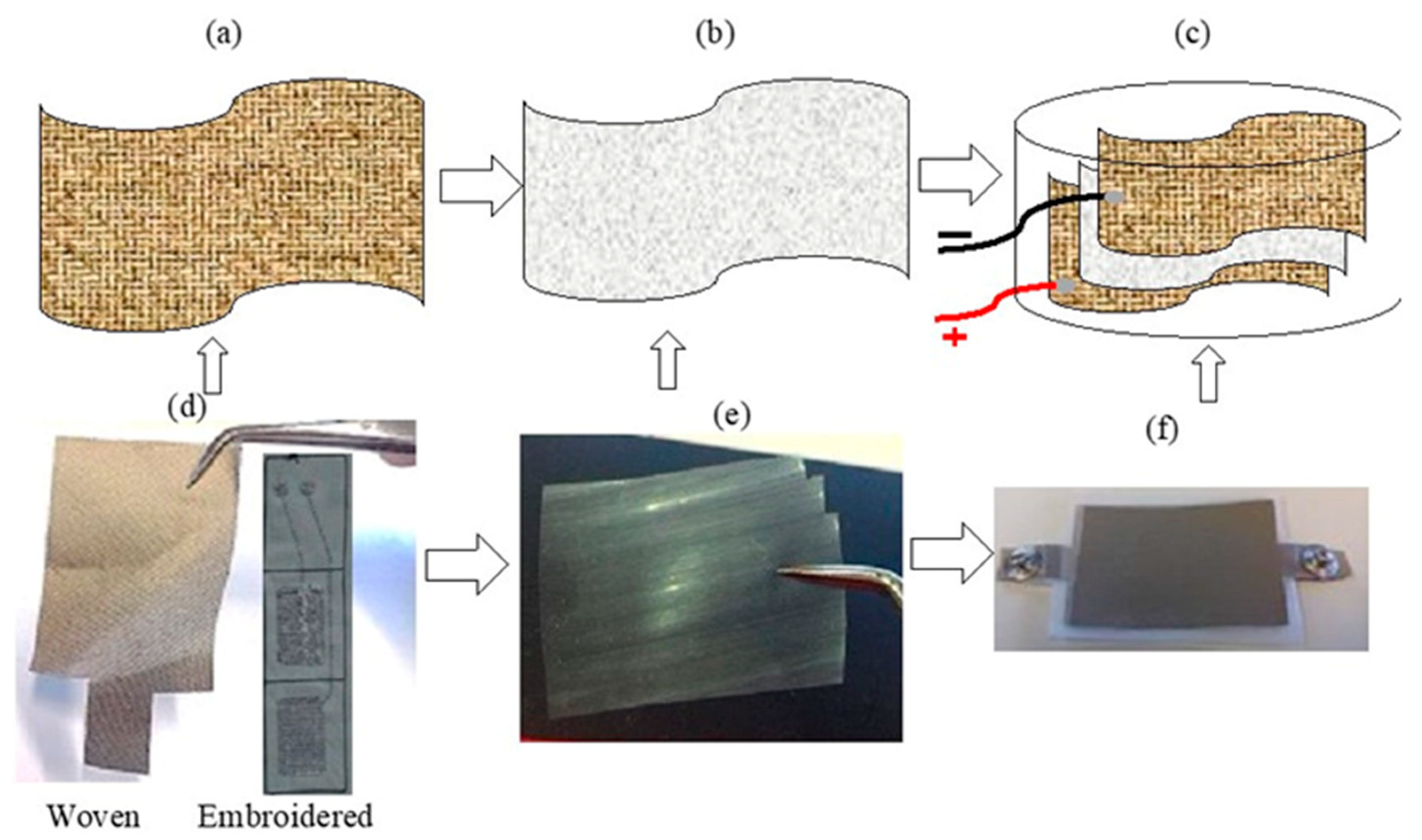
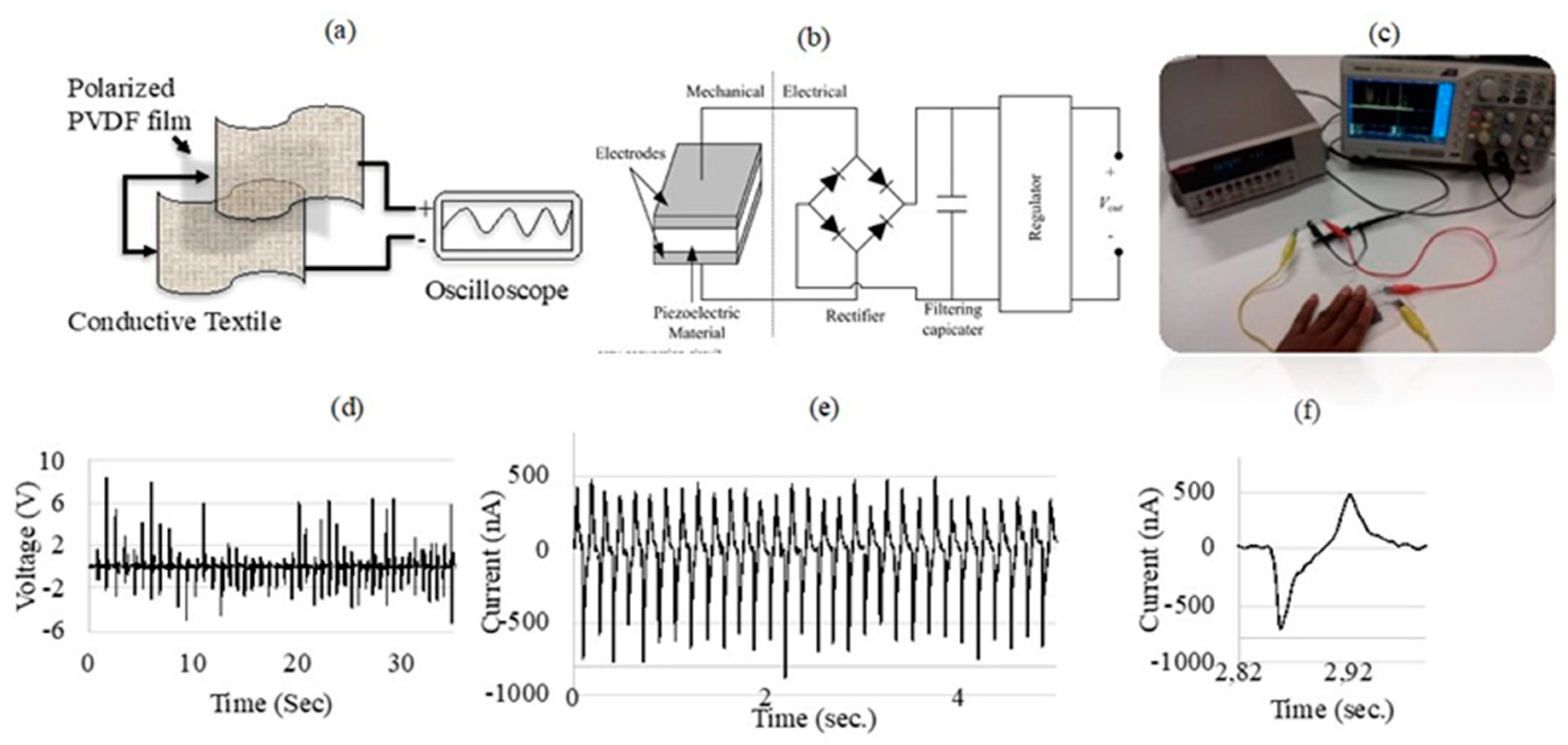
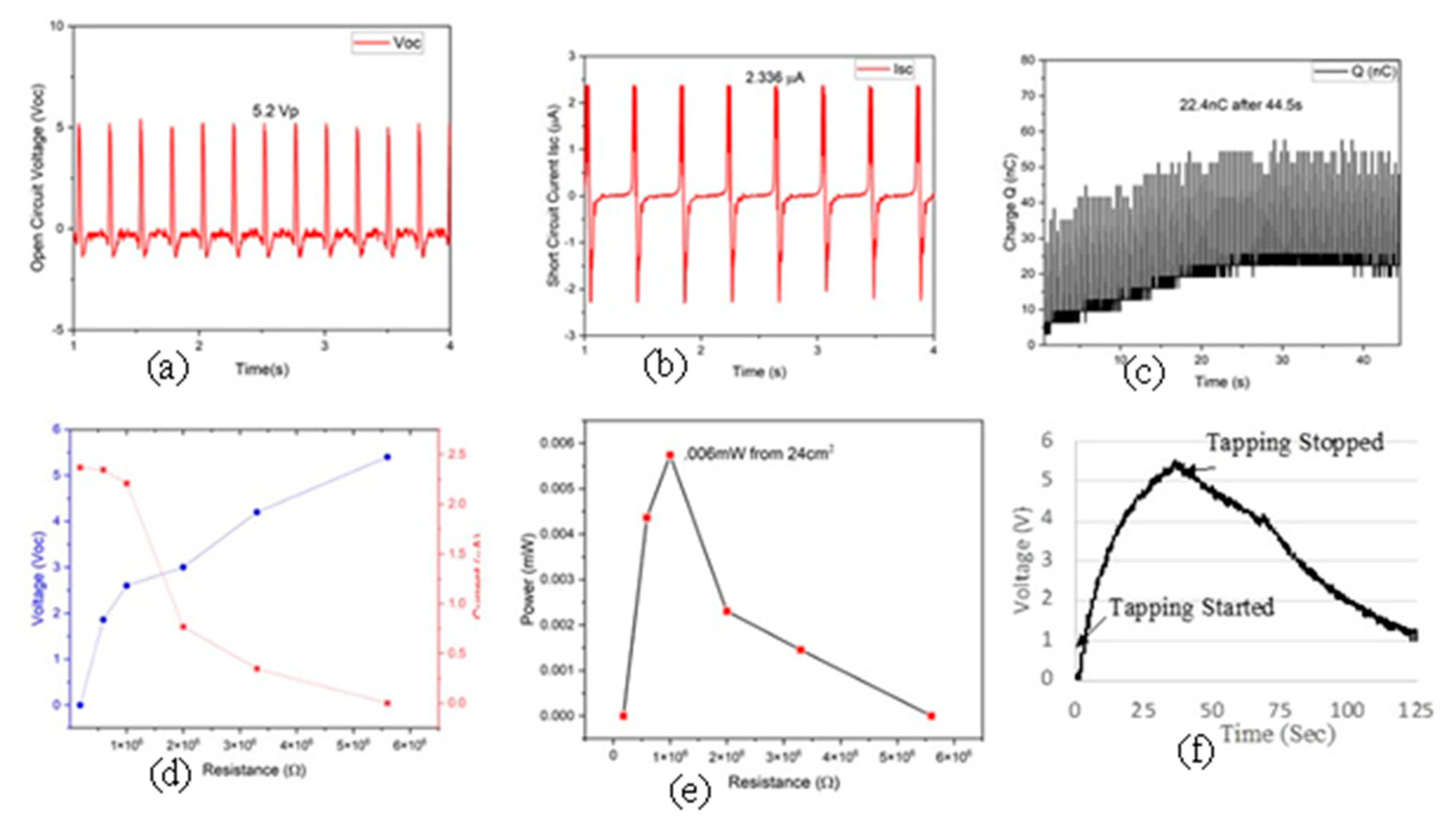

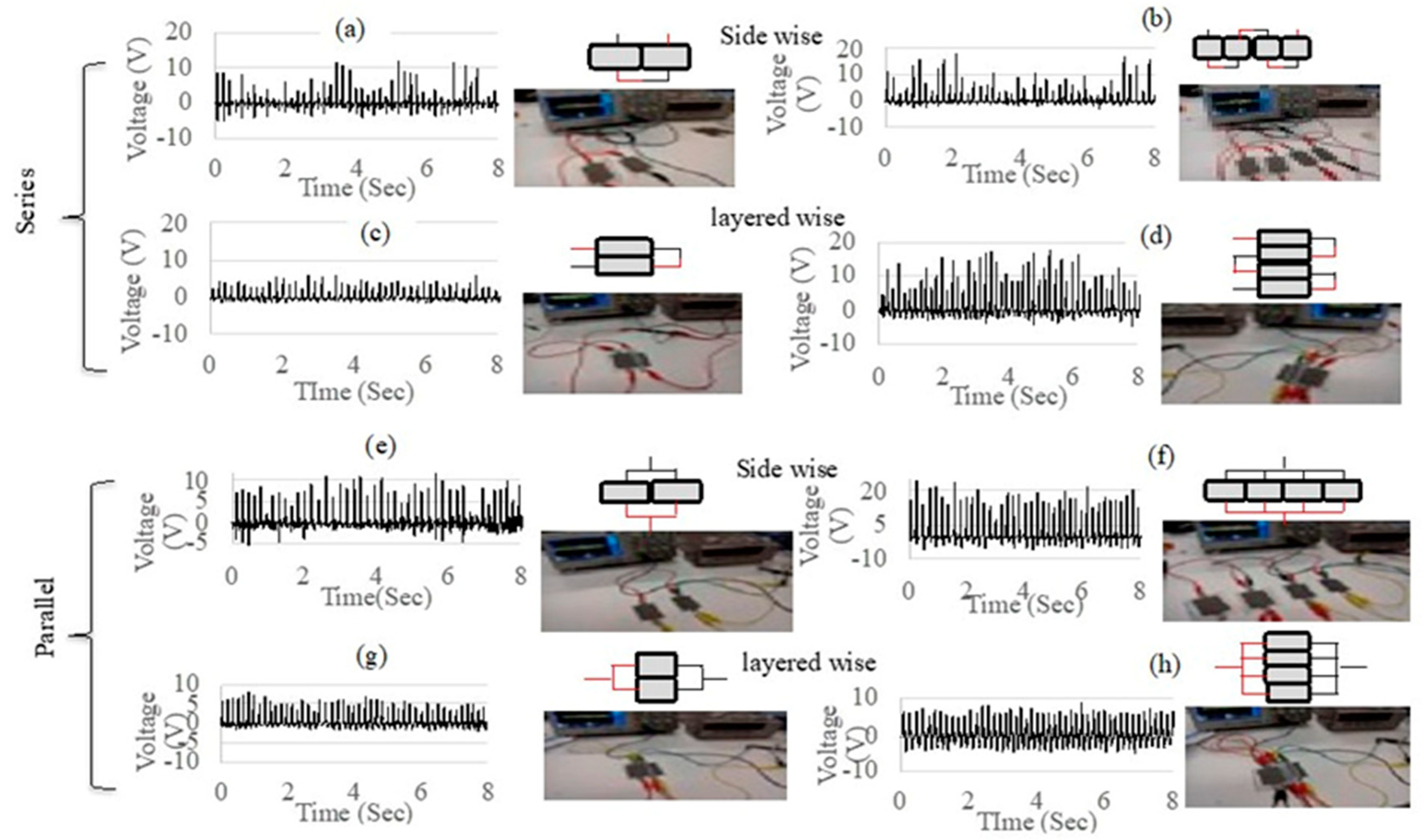
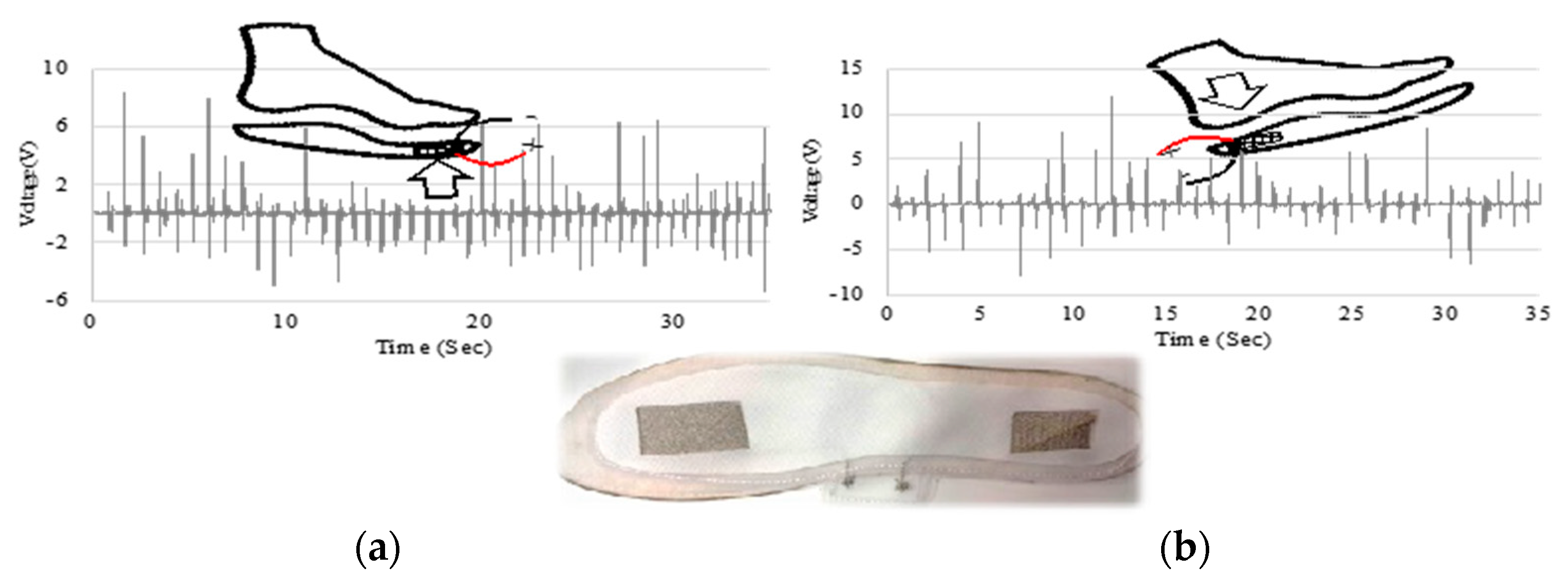
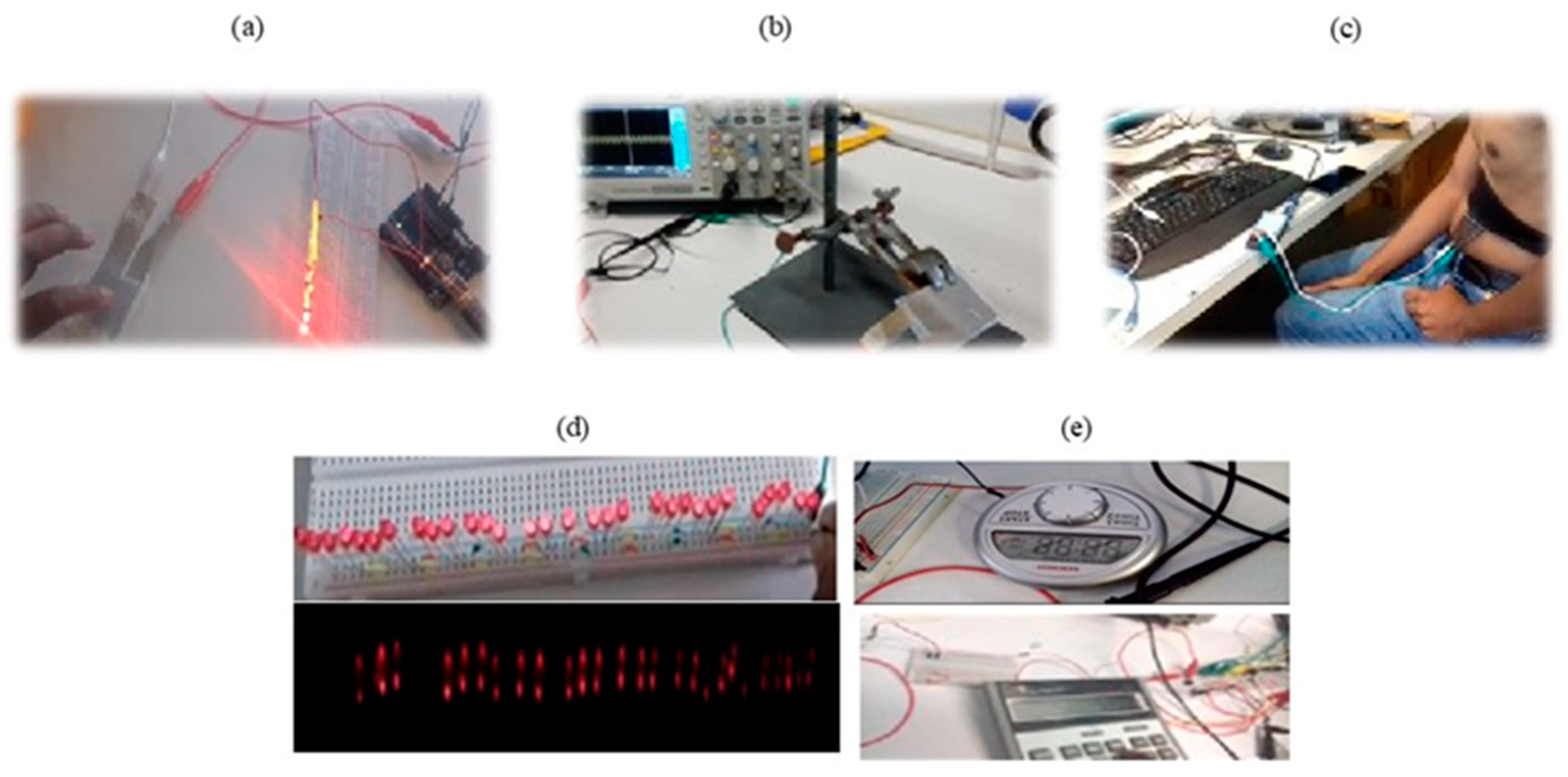
Publisher’s Note: MDPI stays neutral with regard to jurisdictional claims in published maps and institutional affiliations. |
© 2022 by the authors. Licensee MDPI, Basel, Switzerland. This article is an open access article distributed under the terms and conditions of the Creative Commons Attribution (CC BY) license (https://creativecommons.org/licenses/by/4.0/).
Share and Cite
Hossain, I.Z.; Khan, A.; Hossain, G. A Piezoelectric Smart Textile for Energy Harvesting and Wearable Self-Powered Sensors. Energies 2022, 15, 5541. https://doi.org/10.3390/en15155541
Hossain IZ, Khan A, Hossain G. A Piezoelectric Smart Textile for Energy Harvesting and Wearable Self-Powered Sensors. Energies. 2022; 15(15):5541. https://doi.org/10.3390/en15155541
Chicago/Turabian StyleHossain, Ishtia Zahir, Ashaduzzaman Khan, and Gaffar Hossain. 2022. "A Piezoelectric Smart Textile for Energy Harvesting and Wearable Self-Powered Sensors" Energies 15, no. 15: 5541. https://doi.org/10.3390/en15155541
APA StyleHossain, I. Z., Khan, A., & Hossain, G. (2022). A Piezoelectric Smart Textile for Energy Harvesting and Wearable Self-Powered Sensors. Energies, 15(15), 5541. https://doi.org/10.3390/en15155541







